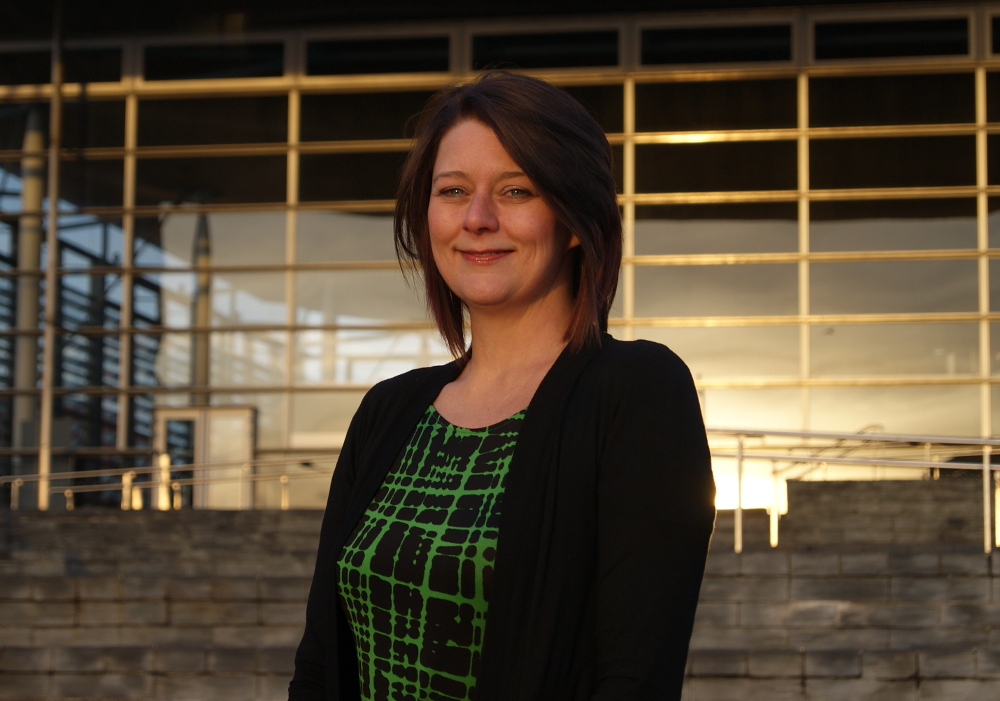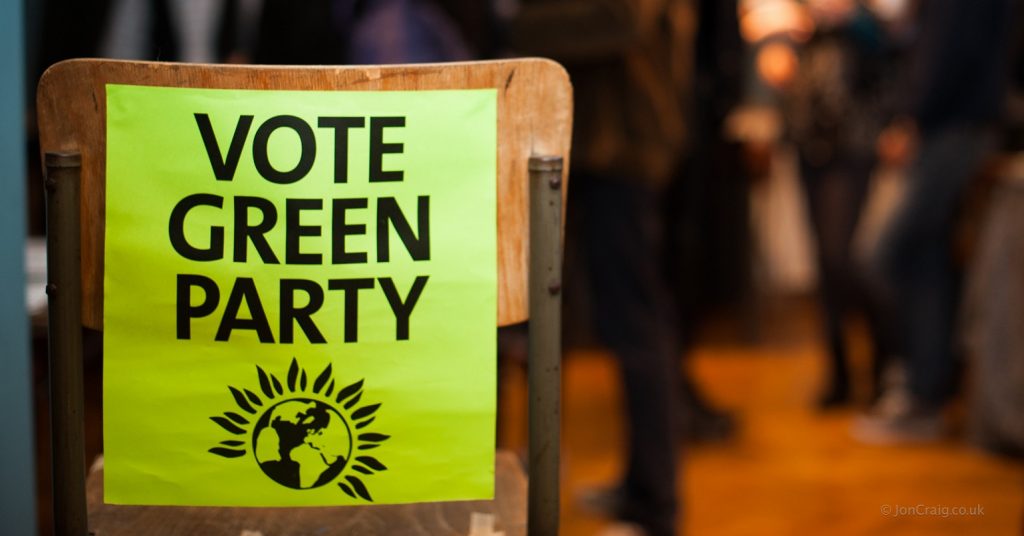The Green Party and Plaid Cymru should make three strategic pacts in Wales

- Alex Randall lives in Machynlleth and has worked on a number of climate change campaigns and projects. He is writing here in a personal capacity.
Plaid Cymru have already called on people in England to vote for the Green Party. The Green Party did not reciprocate by asking green sympathisers in Wales to vote Plaid. To some extent this is understandable as the Greens are standing candidates in many Welsh constituencies.
However, there are three constituencies where pacts should be made. These pacts would protect existing Plaid seats. And tantalisingly open up the possibility of a Plaid / Green alliance taking a seat from the Lib Dems.
Plaid hold three seats in Wales. Dwyfor Meirionnydd is a Plaid stronghold. They will keep it this election without anyone’s help. Plaid’s other two seats are not quite as safe. There is a risk that the surging Green Party could erode some of the Plaid vote in these areas and the seats could be lost. Or even if it isn’t the Greens taking Plaid votes, then new Green voters could bolster Plaid. By forming pacts, Plaid and the Greens could deliver an even more comfortable majority.
In 2010 Plaid took Arfon (a new constituency) with a 5.6% lead over Labour. This lead is predicted to be eroded to only 1.5% – or just under 400 votes. The Green Party didn’t field a candidate in 2010, but are predicted to take over 3% of the vote in May. A Plaid / Green pact would produce a majority of nearer 5% of make a much safer win for Plaid.
Carmarthen East and Dinefwr, is in a similar but slightly stronger position. Plaid took the seat last time with a 9% lead. That lead is predicted to drop to 5% this time around. Plaid will probably hold the seat. But why risk it? A Plaid / Green pact would certainly deliver the seat with a comfortable(ish) majority.
Ceredigion: this where it gets exciting. The Lib Dems are predicted to win the seat. But only just. They might hold the seat with a 1.1% majority. The Electoral Calculus website predicts the percentages like this for May. Lib Dems: 30.1%, Plaid 29%, Greens 7.4%. Plaid and the Greens – you do the maths. Make a pact and you’ll take this seat from the Lib Dems. Don’t form a pact and the Lib Dems will probably keep it. Sure, Plaid might take it on their own. Or they might not. But a pact would deliver the seat, possibly with a 6% majority. This worked before. In 1992 a Plaid / Green pact won the seat, taking it from the Lib Dems. The Lib Dems re-took the seat in 2005 when the Greens fielded their own candidate. The Greens took over 800 votes. The Lib Dems beat Plaid by just over 200 votes.
The problem for the Greens is that in each of these pacts they would be the smaller partner. In each case delivering under 1000 votes to a pact in which Plaid would bring upwards of 12,000. In practice these pacts would mean Greens campaigning for a Plaid candidate.
My sense is that these pacts will probably not be made. But that this is because both Plaid and the Greens misunderstand each other’s politics. The Greens (wrongly) see Plaid as a party only focused on Welsh devolution and championing the Welsh language. Greens often pay little attention to Plaid’s other radical policies. I suspect that many Plaid supporters (again, wrongly) imagine the Green Party as narrowly focused on an environmental agenda and miss the Green’s other radical policies. Many members of both parties support them as part of a profoundly held expression of their identity. Making pacts would require members of both parties to seek out areas where those identities over lap. Or to see past identity and focus on areas of shared policy.
And these areas of shared policy are very strong. Both parties support radical devolution. Both parties oppose austerity. Both parties oppose privatisation, especially of the NHS. Plaid and the Greens present a united front against neoliberalism and the ever growing dominance of wealthy interests over the interests of ordinary people. Of course there are areas where the parties do not see eye to eye. But on the defining issues of this election – austerity, privatisation and the NHS – Plaid and the Greens are on the same page.
The Greens might ask – “well, what do we get in return?”. Probably the vote of every Plaid sympathiser living in England. And this has already been called for by the Plaid leadership. In order for any of this to happen the Green Party leadership in Wales needs to encourage, rather than discourage these pacts. At the moment the Green Party leader in Wales – Pippa Bartalotti – has ruled out any pacts. The first step towards creating these pacts is that the Green Party leadership must be publicly open to them.




Ah, the beauty of the FPTP system. It so effortlessly sets people who would otherwise be political allies at each other’s throats. How else could the Tory-Labour duopoly have kept power for so long while being so crap?
Should you vote tactically in a marginal seat? Should parties like Plaid and the Welsh Greens (or the SNP and Scottish Greens, I suppose) stand down in each other’s favour or endorse each other? All questions that would be meaningless under a fair voting system.
The author makes a practical and pragmatic case for the Greens to stand down in PC seats. The same argument could be used for them to stand down in Labour or SNP target marginals. Why don’t they? Because it wouldn’t be principled to do so. Why should voters be robbed of the chance to vote Green? Tactical voting should be a question for the individual, not the party. (By the way, I don’t notice UKIP and the Tories making any deals.)
As for what to do about FPTP, may I make a suggestion? On May 8, everyone whose vote didn’t count (i.e. those who voted for a losing candidate under FPTP) and feels sufficiently upset about it, should gather at 10 Downing Street and prevent the new PM, whoever it is, from taking office until he (sadly, it will be a he) pledges to introduce a fair voting system as his first act in office. Direct action: it worked for the suffragettes.
I totally agree with you on the injustice of FPTP. It is a cynical ploy by the two major parties to corner permanent empowerment and has been rejected by every European democracy. However, I don’t see revolution as the solution. You could start by challenging it in the international courts.
I am an active plaid member, but lived in London for 10 years. During that time I always voted Green and helped at election time. We are not that different and should find ways to unite rather than fight each other.
David Wilton’s comment is the most sensible one here. For goodness’ sake, get on with it and make a deal, knowing that when you trade you never get all of what you want. If Plaid want to return with four, they will have to bite the bullet and leave the Greens a clear run in a few cobstituencies that they, Plaid, would dearly like to contest. Let’s have no more petty bickering.
The greens are nowhere near strong in Cardiff Central, Cardiff West or Cardiff south and Penarth. There isn’t a shred of evidence to support that. In Canton at the recent 2014 byelction the green vote was decimated. Thew greens haven’t a single elected member in Cardiff. Plaid Cymru are on the up and the only choice for an anti austerity candidate who will put Wales first.
Totally agree with article and comment above. It’s time to be pragmatic to maximise the number of anti-austerity MPs. Surely Plaid could give up a few seats in South East Wales, eg Pippa B’s one.
Brilliant article! Serious, sensible and politically sophisticated. Divided we fall!
Or united we destroy each other and end up on Jeremy Kyle!
No mention of any Welsh seats in which Greens are stronger than Plaid?
Very one sided article. Reads like someone trying win Plaid friends rather than make a reasoned arguement.
There’s no mention here of the strong Green and weak Plaid vote in Swansea West and Gower…
The only agreement is for the SNP Plaid Cymru and Green Party of England to act together after the general election. The Green Party of Wales consists of a bag full of ferrets attacking each other and is not serious political body.
So true Green party in Wales Her Highness Bartolotti is even demanding Organic and fair trade gifts with floral tributes from the hedgerows as a price for talks with Plaid Cymru! I say we keep our floral tributes for the SNP.
“The Green Party of Wales consists of a bag full of ferrets attacking each other” – that was certainly true when I was involved, but then all political parties are like that. You have a better idea? The truly radical position might be to advocate the banning of all political parties, but this would be difficult to implement rigorously!
no mention of a reciprocal deal if we were to agree plaid should agree not to stand candidates in three seats where the greens are strong Cardiff central Cardiff west and Cardiff south and Penarth
It may sound arrogant but I think not standing a candidate would be ruled out by Plaid, it would argue as the ‘self styled party of Wales’ it has to offer itself to every Welsh voter.
As arguably a more ‘mainstream’ party Plaid also takes a pragmatic approach to issues such as nuclear power. Although technically opposed, with an AM representing Ynys Mon the party tolerates it representatives adopting their own policies in support of the nuclear power station. Supporting Plaid candidates could potentially cause more problems for the Greens.
Yes, it sounds arrogant. Perhaps the “party of Wales” should try to think harder about what would be best for Wales, although I realise that political parties find this difficult.
Pardon me – but at the last election, Plaid Cymru outvoted the Green Party by substantial margins in all three of the Cardiff constituencies and it would be truly miraculous if either had a hope of winning. I’m all for two-way standing-downs but this needs to be based on shared policies and a touch of realism – not crude bargaining.
Is john Coxs undemocratic communist sect standing? Have they ever stood down? Never mind 5 years ago In Canton at the recent 2014 by-election the green vote was decimated. The greens haven’t a single elected member in Cardiff. Plaid Cymru are on the up and the only choice for an anti austerity candidate who will put Wales first.
Is there no moderation exercised here? I am not a member of an “undemocratic communist sect” and don’t live anywhere near Cardiff or Canton – but you allow an anonymous “womensvoice” to slander me. Is this normal here?
What would be really truly miraculous would be a political “deal” in which there was no detectable reciprocity. Maybe John Matthews’ proposal sounded a bit blunt, but bargaining there would have to be, based as you say on shared policies and analysis, and on realism. Otherwise Plaid will just have to manage on their own. There’s nothing necessarily wrong with political bargaining, as long as it’s done openly not under the counter. Strangely, many people in the UK still find this odd. Just wait till we get PR!
Flabbergasted by the Green Party in Wales diatribe against Plaid Cymru by Pippa Bartolotti and Anthony Slaughter Bartolotti “Leanne’s last word to us were, and this is pretty much the direct quote: “You stand down in Ceredigion, and we’ll see if there is something we can do after that.” These were not the words of a leader of a political party interested in a deal.” Then there are unfounded accusations against Plaid members!! http://wales.greenparty.org.uk/news.html/2015/02/14/statement-from-pippa-bartolotti,-wales-green-party-leader,-to-candidates-and-members/